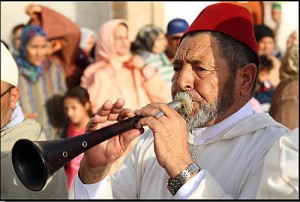Music from Northern Africa

An old man playing a Rhaita, a double reed instrument from Northern Africa.It is one of the primary instruments used by the Master Musicians of Jajouka and Master Musicians of Joujouka, two traditional music ensembles from Morocco.
About: Music from Northern Africa has contributed much to popular music, especially Egyptian classical and el Gil, Algerian raï and Moroccan chaabi. The broad region is sometimes called the Maghreb (excluding Egypt), and the term Maghrebian music is in use. For a variety of reasons, Tunisia and Libya do not have as extensive a popular tradition as their neighbors on both sides. Folk music, however, abounds, despite frequent condemnation and suppression from governments, and exists in multiple forms across the region—the Berbers, Sephardic Jews, Tuaregs and Nubians, for example, retain musical traditions with ancient roots.
Andalusian music is especially influential, and is played in widely-varying forms across the region. This music was imported from Andalusia in the 15th century, after Spain expelled the Moors from that province. The Spanish conquest of the historically Muslim Iberian peninsula had been going on for some time, and had the result of moving a large number of Iberian Muslims, who were themselves descended from people from across the Mediterranean, into North Africa. These people brought with them a vibrant tradition that had arisen as a fusion of various kinds of Muslim music from Baghdad, Istanbul, Egypt and elsewhere. The most well-known derivatives of this style are al-âla in Morocco, nuubaat and related styles in Algeria and malouf in Tunisia.1
Similarities to other music styles: Although the musical styles and instruments used in sub-Saharan Africa share many similarities across borders, the music of Northern Africa vary greatly from country to country. The musical instruments used in Egypt differ from those used in Libya or Tunisia. Although there are vast differences between styles in Northern Africa, they all share an Arabic cultural influence and origin. 2
Influences: The African music instrument, like the human race, originated in the cradle of humanity; Africa. It is from here that all the musical instruments we use around the world today originated.
This is especially true of the instruments of Northern Africa which have a decidedly Islamic flair. Nearly all the Western instruments used in Europe and the Americas started here from wind instruments to the strings like guitar and violin.3
DISCOVER MORE
Article from Afropop Worldwide by Banning Eyre
Often overlooked in discussions of African music, the countries of northern Africa link the continent to the Mediterranean world, and particularly to the rest of the Arabic-speaking world, which at over 200 million people, makes up one of the largest regions on earth to share a common culture and language. By the time Arabs came into north Africa in the 7th century, the indigenous Berber peoples had had their once pastoral lives transformed by desertification throughout the region. Living in the remote Atlas mountains and in nomadic enclaves, they resisted invaders as best they could, but wound up on the losing end of the region’s political struggles. Nevertheless, they remain an important source of today’s north African music. (See Berber Music.)
The story of north Africa’s recording industry begins in Cairo, Egypt, where the Odeon label started up in 1904, producing over 400 titles before World War I. Given Cairo’s continuing dominance as a music center, a thumbnail sketch of northern Africa’s modern music naturally starts there.
In the grand halls of Cairo today, large firquah orchestras combine western and Middle Eastern classical instruments, playing music that carefully preserves and extends centuries-old traditions. The scales, or maqam, and forms used in this music, and the time-honored themes in the classical poetry that singers interpret-all exemplified in the works of singer and legend Oum Kalsoum-may seem rarefied upon first listen. But for Arabic-speaking peoples, deeply concerned with their history, both the music and the words resonate in ways that have no exact parallel in the western world. Meanwhile, in Cairo’s modern recording studios, young pop singers and high-tech troubadours from the city’s blue-collar neighborhoods pour their hearts out in plain-spoken, topical confession and complaint. Both Cairo’s venerable traditions and its earthy modern pop hold sway over musicians and audiences across the Maghreb, the region that stretches from Libya to the Atlantic, to include Tunisia, Algeria and Morocco-the country known to Arabs as Maghreb Al Aqsa, the extreme west-then south across the Sahara to the Senegal River.
Arab classical music begins with singing, the human voice, a fact that helps account for the amazingly controlled vocal techniques-from delicate whispers to quivering, swooping wails-found in North African music. The singer’s art focuses on the interpretation of a text. Vocal techniques serve to amplify and color various levels of meaning in the words. Instrumental improvisation parallels this process as virtuosos playing the nay, qanoon or oud–ancestors of the European flute, zither, and lute respectively–explore the possibilities inherent in a particular scale or composition. Double-reed instruments such as the oboe-like mizmar baladi produce an evocative range of vibrant, shrill tonalities. The region’s most popular percussion instruments–the frame drum, sometimes called tar or bendir, and the goblet-shaped derbouka–give many styles of music a sensuous undertow that reminds us that Arab percussion is a long lost cousin of the world’s great Latin styles. Various bells, chimes, and castanets ornament some traditional styles, reflecting musical input from the Middle East and beyond.
Northern African music also includes elements of sub-Saharan traditions. The dense rhythms and deep trance incantations of Morocco’s Gnawa brotherhood offers one striking example, but the African element can often turn up neatly integrated within otherwise Arab sounds-a particular 6/8 rhythm, an old traditional melody, or a call-and-response vocal or instrumental arrangement.
As elsewhere in Africa, religion and colonialism complicate the story of today’s music. Islamic political authorities have pursued an ambivalent relationship with musicians and music. The religion first arrived in north Africa around 640 AD, and though it now thrives mostly in north and West Africa, Islam once stretched as far as the ancient city of Great Zimbabwe, thousands of miles to the south. Initially, music played no significant role in Islam, but musical expression enriched Koranic chanting and the call to prayer. But the centuries have seen steady growth in Islamic musical traditions-the development of classical styles and compositions and the rise of dignified star singers, beginning with Ibn Misjah and Ziryab, “The Blackbird,” an exiled Iraqi who lived in the Maghreb and later helped originate Moorish Spain’s Andalusian music tradition, which influenced Western classic music. Often shunned by orthodox Islam, mystical sects have also developed trance music traditions, where the performance becomes a form of devotion designed to induce states of higher consciousness.
In pre-Islamic North Africa, women dominated the music of the Berbers who lived there. In the past century, women have often ranked as the most celebrated singers in North African traditions. But with noteworthy exceptions, such as the women iggawin (traditional musicians) of Mauritania, they typically play instruments only in private settings, not as a profession.
Today, religion and music find themselves increasingly at odds in this region. With both Muslim fundamentalism and frank, youth-oriented pop music on the rise, the confrontation can reach deadly extremes. In Algeria, pop singers and producers face the real possibility of summary death sentences as punishment for openly discussing the passions of youth, romantic love, or drinking alcohol. In Egypt, which has also seen violence in the arts world, every pop song must win the approval of government censors before it hits the market. And in Morocco, Berber singer Matoub Lounes was ambushed and killed in 1998, presumably for his vocal advocacy of his peoples’ cause.
Ethiopia and Sudan are not exclusively Islamic. Christianity dominates in Ethiopia, though many more ancient cultures survive there as well. In Sudan, Africa’s largest country, the Nile flows from animist and Christian areas in the south to the Islamic north, but in contrast to most other northern African nations, history has not yet quelled religious and cultural animosities, and endemic warfare persists between these sharply divided regions. Though the British colonized Egypt and Sudan, the Italians briefly held Libya and Ethiopia, and the Spanish controlled northern Morocco and the Western Sahara, the French controlled more territory, had more widespread influence and left a more European imprint on this region.4
VIDEOS
Acoustic North African Band
North African Berber Music
Source:
1.South African Music, South African Tours & Travel: http://www.south-africa-tours-and-travel.com/south-african-music.html
2.North African Instruments, eHow.com: http://www.ehow.com/list_7306648_north-african-instruments.html#ixzz1TvQ7xph4
3.http://www.africanmusicblog.com/tag/northern-africa
http://www.afropop.org/explore/region_info/ID/2/North%20Africa/









